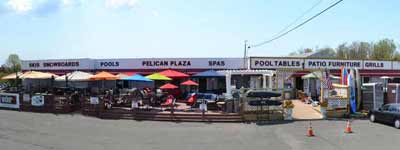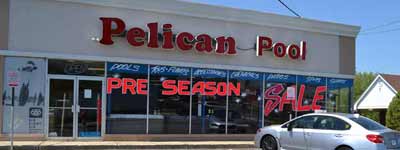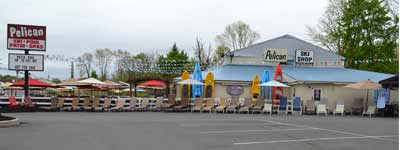Hot Tub Buyer's Guide
The 5 minutes it takes to read this page could save you $ thousands
There are over a hundred and sixty different brands of acrylic spas sold in the U.S.A., and the quality varies as much between brands as with automobiles. It is difficult to get accurate information to make brand comparisons, since impartial studies from non-commercial sources like Consumer Reports magazine are lacking.
Unfortunately, if you search online for spa ratings, it is pretty difficult, if not impossible to get unbiased information Most of what you will find online is either provided by manufacturers themselves, or by paid advertising websites that are far from impartial.
We won't claim that our opinions are 100% unbiased-- obviously we believe that the spas we have chosen to offer our customers are the best value and technology and performance in the entire industry- We do however claim that the following information is designed to help you choose the right spa for your purposes and make an informed choice so you can draw your own conclusions.
-
Location
Decide where you would like to put your spa. One trick for envisioning outdoor locations is to outline the hot tub's dimensions with duct tape, rope or spray paint . This will give you a visual perspective and help make the decision easier. Consider how close you are to a door as this will directly impact how much you use your spa in the winter.
Make sure you will have privacy as well as room around the spa for additional seating if you are entertaining. Also be sure that the main seats are facing the best view, it's much more relaxing to watch a sunset than it is to stare at the side of your house.
-
Site Preparation
Concrete is a good, long-term foundation base however pavers, decks, Gravel or crushed rock are also acceptable bases. If you plan a deck site, you must first determine the deck's maximum load capacity. Consult with a qualified building contractor or structural engineer before placing your hot tub on an elevated deck.
Since a filled spa will have considerable weight, make sure it is placed on a structurally-sound surface which will support the weight of the spa, water, and occupants. Uneven and unsound surfaces can damage the spa and void your warranty. Make sure that the site has adequate drainage so that rainwater will not be able to pool around the spa. Leave access to the hot tub's removable equipment compartment panel for future service needs.
-
Electrical Hookup
Full-sized acrylic spas are designed for the most part to operate on hard-wired, GFCI-protected 220-240V 50 amp circuits. Some spas with multiple pumps may require a 60 amp service. Ask your salesman for specifications.
These spas must be wired by a qualified electrician. The National Electrical Code specifies that a manual disconnect device for your hot tub be installed at least 5 ft. away, and within line of sight of the spa for safety. Consult with your local building department for additional information.
-
Spa Construction - Roto-Molded Hot Tubs
Are usually low to Midrange priced, these spas, such as our value-priced Durasport Spa Series, are constructed with the shell and surrounding cabinet as a single piece by means of a unique, rotational molding process. These hot tubs have molded seating and generally are plug-n-play spas which operate on standard 110-120V 15A household power outlets. There is a definite limit to the size and performance in which roto-molded spas can be made. But if the size of these spas meets your needs, their great value makes them an attractive choice. Strong spas are designed for indoor or outdoor use, in all climates. They are easy to maintain and service, and are very durable. No plumbing is required. Max temperature is 104º F.
-
Spa Construction - Acrylic Hot Tubs
Most people buy acrylic spas because of their outstanding durability, great variety of shapes and sizes, and for their unsurpassed hydrotherapy and seating comfort. These spas have a cast acrylic shell, supported by a frame structure, and are usually surrounded by a skirt of either cedar or simulated wood-grain plastic. They come in a wide variety of sizes, seating from two to seven persons or more.
Acrylic spas are generally built for operation outdoors in all climates, although they can be installed indoors as well. Most acrylic spas are 220V hard wired, but some models are available in either 110V or 220V. No plumbing is required. Max temperature is 104º F, as with all spas sold today,
When choosing an acrylic spa with be sure that the frame and shell are able to handle the weight of the water and people in the spa. A spa shell that flexes will undoubtedly produce stress cracks as time goes on . A good way to test for a well built spa is to stand in the middle of it dry and jump up and down. A poorly made spa will flex under your weight.
-
Acrylic Hot Tubs
Most people buy acrylic spas because of their outstanding durability, great variety of shapes and sizes, and for their unsurpassed hydrotherapy and seating comfort. These spas have a cast acrylic shell, supported by a frame structure, and are usually surrounded by a skirt of either cedar or simulated wood-grain plastic. They come in a wide variety of sizes, seating from two to seven persons or more.
Acrylic spas are generally built for operation outdoors in all climates, although they can be installed indoors as well. Most acrylic spas are 220V hard wired, but some models are available in either 110V or 220V. No plumbing is required. Max temperature is 104º F, as with all spas sold today,
When choosing an acrylic spa with be sure that the frame and shell are able to handle the weight of the water and people in the spa. A spa shell that flexes will undoubtedly produce stress cracks as time goes on . A good way to test for a well built spa is to stand in the middle of it dry and jump up and down. A poorly made spa will flex under your weight.
-
Seating Arrangement & Capacity Desired
Before deciding upon which spa to buy, think about how you'll use it. If you want to entertain, a large, company- and family-friendly model with plenty of seating might be the way to go. A deeper, less contoured tub is ideal for exercising. If relaxation is your goal, check out spas with a lounge seat or captain's chair.
The seating capacity of your spa, determined by its length and width, is important. You will of course want to choose a spa that meets your needs in terms of the number of bathers that will be using it. If you have a large family, and they will all be using the spa, you may need a larger spa than a single person or retired couple. But the fact of the matter is that the third dimension (height/depth) is more important .Deep spas cost more to manufacture, so lesser brands scrimp on materials by building them short. Since you're buying a spa for the pleasure of immersion, be sure to check all of the dimensions when comparing spas so that you don't waste money on a shallow spa, which you may deeply regret later.
-
Jetting, Horsepower & Blowers
Jetting should be engineered for hydrotherapy action, comfort & optimum energy efficiency, not mere numbers. Believe it, sitting in a spa seat and having your back assaulted by dozens of tiny jets can quickly become a painfully annoying experience.
Well-engineered spas provide vigorous, soothing hydro massage without dozens of useless extra jets. A good design also provides quiet zones for people who just want to soak, unwind, and relax.
Buy a spa with the perfectly balanced ratio of quality jets to horsepower for a much better value. Beware of spas that brag of many jets but no horsepower to back it up . HP ratings are not yet standardized in the spa industry, so some manufacturers will greatly exaggerate their ratings and/or use made-up terms like "MRHP" (market rated horsepower).
An air blower in an acrylic spa is a very bad idea. Although popular years ago, most good manufacturers have abandoned them. Blowers reappeared recently at some online sellers. Why? Again, they count the tiny air orifices as "jets" in their jet-count advertising.
-
Insulation
There are many ways to insulate a hot tub however you must remember heat rises, and most of a spa's heat loss is through the top cover, not the spa sides. (Just as in your home, most heat loss is through your attic, not the walls) for information on the choosing the insulation for your hot tub click this link.
-
Ozonators, Sanitization & Salt Sanitation System
Some retailers will promote ozonators as sanitizer for your hot tub. This simply isn't true, ozone is a helper, and can oxidize some contaminants, but it will not replace spa sanitizers or keep the water clean by itself. If you've never owned a spa before, keep in mind that since the water is kept for 2 – 9 months, it is necessary to use a sanitizer system to keep it clear, clean, and odor-free, Chlorine and bromine are the two proven sanitizers used most in hot tubs. They can be added to the water by using floating tablets, powder, or generated automatically directly through a Salt system.
Lowest Prices Guaranteed On All Hot Tubs!
ORDER YOURS TODAY!















